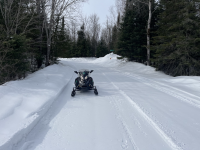I read people talk about paid groomers or volunteer groomers, grooming done at night vs the day. I'm wondering how all that is managed, mostly for WI and MI or maybe MN. Many like to complain about groomers (trail groomers not the other kind) but I don't think many including myself understand what goes in to making a trail smooth. Trail grooming to me seems like a thankless job as everyone likes to whine but not figure out how to help.
Funding: I'm assuming trails are managed by clubs, and funding comes into the clubs either from the state/DNR from trail permits or registration or perhaps gas taxes, or it comes in from donations or fundraising. For funds coming from the DNR, it is based on miles of trails or miles groomed? Do they send more based on traffic or amount of snow - what's involved in determining this? Do they get X dollars for a season or is that variable based on weather?
Paid vs volunteer - is this determined by the club, with some kind of assessment of what they can afford?
Equipment - same as above - is this determined by the club based on their budget? Or does the DNR impact this?
How often to groom - night groom vs day groom - trails can never be groomed enough based on how you hear people talking. But who makes the call on when to send the groomer out? I assume the night vs day is at least partly a function of what help the club can get.
How can we as rider help out? Donating time or money, watching how and when we ride?
Anything else to know? Thanks.
Funding: I'm assuming trails are managed by clubs, and funding comes into the clubs either from the state/DNR from trail permits or registration or perhaps gas taxes, or it comes in from donations or fundraising. For funds coming from the DNR, it is based on miles of trails or miles groomed? Do they send more based on traffic or amount of snow - what's involved in determining this? Do they get X dollars for a season or is that variable based on weather?
Paid vs volunteer - is this determined by the club, with some kind of assessment of what they can afford?
Equipment - same as above - is this determined by the club based on their budget? Or does the DNR impact this?
How often to groom - night groom vs day groom - trails can never be groomed enough based on how you hear people talking. But who makes the call on when to send the groomer out? I assume the night vs day is at least partly a function of what help the club can get.
How can we as rider help out? Donating time or money, watching how and when we ride?
Anything else to know? Thanks.


